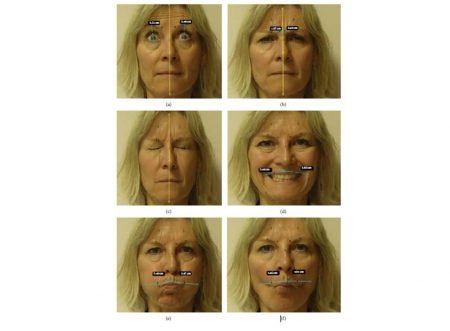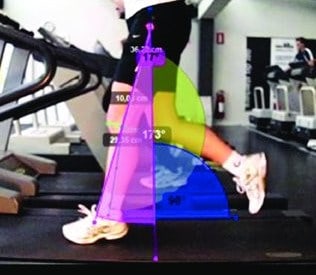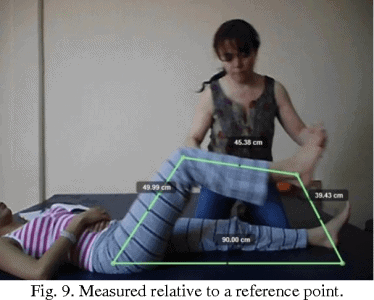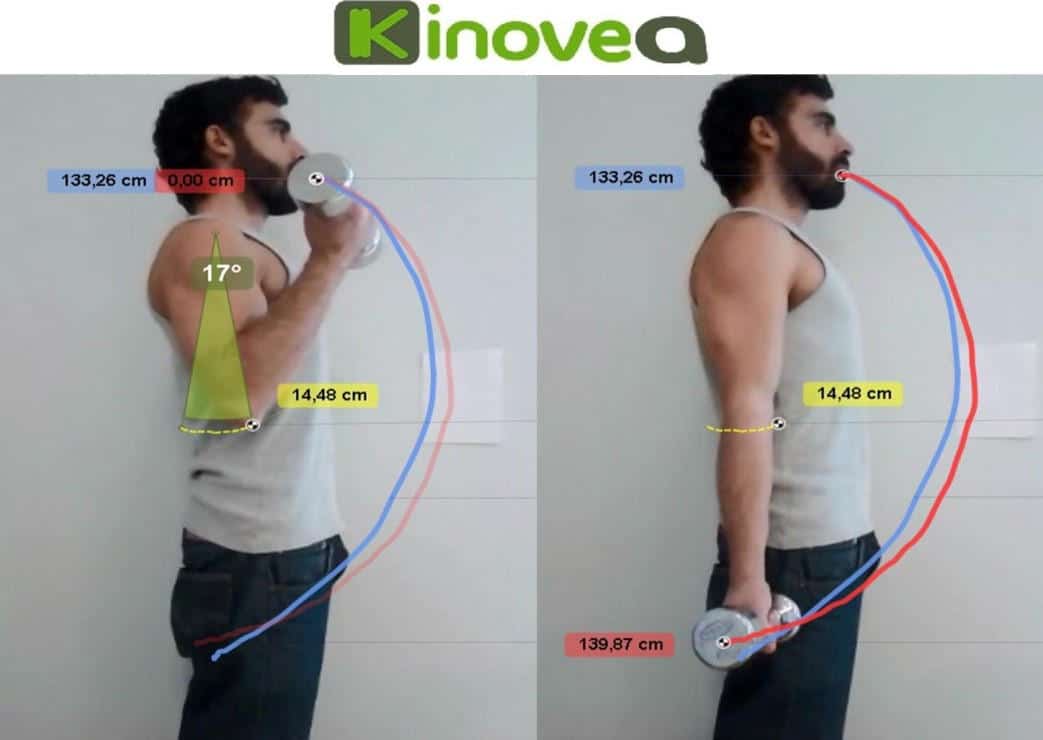In the following article, we study the software Kinovea for movement analysis in different fields and aspects of Sport and Physical Activity.
Technology is a fundamental tool for recording information, facilitating its understanding, and aiding decision-making (1). However, technological advances must be subject to review and research to verify their validity and reliability.
Kinovea
Conceptualization
Kinovea is a free software and open source for the analysis, comparison, measurement, and evaluation of the movement of body joints (2,3,5,6,7,8,9).
Specifically, it allows analyzing the gesture and sports technique (9) from a qualitative and quantitative point of view (10).
Features
- Targeted at Sports Professionals (researchers, physical education teachers, physical trainers, and sports rehabilitation specialists), Health Professionals (physiotherapists, doctors, and occupational therapists), and Athletes (2,4,5,6,11,12).
- Free (6).
- Ease of use (2,4,6,11).
- Measurement of passive and active range of motion (5).
- Analysis, comparison, and evaluation of sports and training programs (11).
- Tracking of pre-selected points during movements (2).
- Measurement of angles, distances, and times, manually or using semi-automatic tracking to follow points and verify values or trajectories live (1,2,9).
- Exporting data to a spreadsheet with the results of the movement analysis (5).
- Display of video images at regular intervals (6).
- Playback of movement in reverse (6).
- Possibility of slow-motion analysis (6,12).
- Processing of almost any file, so there is no need to worry about formats and codecs (12).
Cons
- 2D software (6).
- Requirements: having a camera and a Laptop with Kinovea installed (6).
- Time investment for the development of the analysis.
Research on the use of Kinovea
Vertical jump flight time
Flight time is the most precise and frequently used variable when evaluating the height of vertical jumps. Therefore, Balsalobre-Fernández, Tejero-González, del Campo-Vecino & Bavaresco (4) analyzed the validity and reliability of the HSC-Kinovea method for measuring flight time and vertical jump height.
Consequently, 25 active CAFyD students performed a total of 125 vertical jumps on an infrared (IR) platform while being simultaneously recorded with a high-speed camera (HSC). Finally, the HSC-Kinovea method is extremely accurate, reliable, and valid for measuring the flight time of vertical jumps.
Facial movements
Peripheral Facial Paresis causes a deterioration of facial movement that may be important to quantify (2). A group of researchers (2) set out to design a tool for measuring two-dimensional facial movement (Figure 1).
As a result, three evaluators placed facial markers on 10 healthy individuals, recorded the maximum bilateral contractions on video, and subsequently analyzed them with Kinovea. In conclusion, this instrument proved to be reliable in healthy subjects and in the frontal muscle.

Sports technique
In the present study (10), a guide is provided for the analysis of the pole vault technique. Motion analysis software (such as Kinovea) allows studying sports technique at a qualitative and quantitative level.
On one hand, qualitative analysis describes the movement without the help of numerical values.
On the other hand, quantitative analysis provides a specific value and details an aspect of the athlete’s execution. From this evaluation, guidelines can be established to guide the athlete’s training. It also allows setting short, medium, and long-term goals to correct the errors found.
Knee hyperextension
This pathology can cause laxity of the posterior structures of the knee. To address this, Dalal et al. (13) tested the effectiveness of prowling along with proprioceptive training on the range of knee hyperextension (assessment with Kinovea), the range of dorsiflexion (evaluation with Kinovea), and the spatiotemporal parameters of gait (Wisconsin Gait Scale). Then, 32 subjects were randomized into 2 groups, the experimental group received physiotherapy, prowling, and proprioceptive training.
The resolution determined that prowling treatment along with proprioceptive training is effective in reducing knee hyperextension, increasing dorsiflexion range, and improving spatiotemporal gait parameters.
Running
Joint kinematics during running is mainly quantified through two-dimensional (2D) video recordings. The applicability of this approach depends on the clinicians’ ability to quantify it reliably.
For this reason, Damsted, Nielsen & Larsen (3) investigated intra- and inter-evaluator reliability for quantifying knee and hip angles during the foot strike of running (Figure 2).
Eighteen recreational runners were recorded during treadmill running. Subsequently, two blind evaluators quantified the joint angles in each video using the Kinovea software.
In conclusion, intra- and inter-evaluator reliability is sufficient to encourage clinicians to continue using 2D motion analysis techniques in clinical practice.

Muay-Thai fights
The temporal analysis of matches enables the study of fighting patterns in combat sports (14). Through this procedure, the types of effort in specific training can be recreated (14).
For this purpose, the Kinovea software was used to analyze the movement time of national-level official Muay-Thai competitions (14).
Wrist range of motion
Two important biomechanical properties of the musculoskeletal system are joint mobility (ROM) and muscle strength (5).
The reliable and accurate evaluation of range and movement patterns is a concern for a clinician (5).
This concern led to the research (5) of the inter- and intra-evaluator reliability of the Kinovea program for measuring the ROM of the dominant wrist joint.
The outcome translates to the Kinovea program being highly reliable in the inter- and intra-evaluator assessment of wrist joint ROM.
Cervical ROM
Cervical disorders are a significant source of disability (6). The evaluation of ROM using valid and reliable tools is a key element when assessing a patient with cervical disorders (6).
In relation to this, the intra- and inter-evaluator reliability of the Kinovea software program for measuring ROM in the sagittal plane was investigated (figure 3).
The results concluded that this tool presented excellent inter- and intra-evaluator reliability in measuring cervical ROM in the sagittal plane (P <0.05).

Surgical skills
The advantages of evaluating performance capacity during laparoscopic procedures without the need for additional equipment are clear. Fortunately, this would allow for an objective clinical evaluation (15). Additionally, a software-based solution would allow for a retrospective evaluation of surgical procedures (15). Therefore, the objective of Ganni et al. (15) was to evaluate whether it is possible to extract a set of objective criteria from conventional laparoscopic cholecystectomy videos by tracking movement with Kinovea. The effect was the proportion of a clear discrimination between the performance of experts and novices.
BMX supercross
Regarding the BMX Supercross cycling modality, the validity and intra-tester reliability of a new method (GoPro cameras, Kinovea, and Matlab) for kinematic measurement were quantified (16).
Specifically, the measurement of joint angles of an athlete in the starting action performed at the starting gate was studied. Finally, this methodology is valid in 2° and reliable in 6°, for the calculation of joint angles during the first 1.25″.
Lower limbs
Rehabilitation aims to restore the movement of a limb after illness or injury (11). For ROM monitoring, the use of goniometry is widely demanded, especially in the lower limbs (11).
However, the goniometer is a tool for measuring angular change in systems with a single degree of freedom (11). That is, the assessment of combined movements would be impaired.
The solution has been the use of the motion analysis program Kinovea (figure 4). This tool allows evaluating the patient’s progress in combined movements without the need for physical sensors (11).

Gait
The measurement of kinematics and ground reaction forces (GRF) during gait are useful for determining treatment effectiveness (17).
The problem arises in the cost of maintaining a gait analysis system (17). As a result, Littrel et al. (17) validated a gait analysis system consisting of a Wii Balance Board, a video camera, and the Kinovea software. However, this method cannot replace multi-camera systems and force platforms.
Podiatry
The goal of any image analysis for clinical biomechanical study is the observation of different synchronized planes (9). And on the other hand, allowing comparisons of these patient analysis planes with and without treatment (9).
To conclude, it should be noted that Kinovea is a practical tool for biomechanical studies in the clinic, allowing the incorporation of qualitative observational elements (9).
Occipital neuralgia
Occipital neuralgia (ON) is defined as “unilateral or bilateral paroxysmal pain, of acute nature, located in the back of the scalp in the distribution of the greater, lesser, and third occipital nerves” (18). Regarding this, López-Soto et al. (18) evaluated the application of a non-invasive intervention.
The retrospective study consists of a postural modification with personalized models (Win-Track and Kinovea) and osteopathy. Finally, it could be concluded that after the non-invasive intervention, the level of neuropathic pain significantly decreased.
Hamstring flexibility
The length of the hamstring muscle plays an important role in the effectiveness and efficiency of basic human movements (8).
The most used and reliable approaches in the scientific literature to measure the extensibility of this musculature are (8): Sit-and-Reach, Hip Joint Angle (HJA), and active knee extension.
However, the Kinovea software program could be included, determined as reliable (a = 0.90) after the descriptive study by Moral-Muñoz et al. (8).
These results support the use of this free software to assess the flexibility of the hamstring muscles in an adolescent population.
Lumbar spine
Rozan, Rouhollahi, Rastogi & Dureha (19) evaluated the effects of physiological loading on the lumbar spine in national male players of different sports (Cricket, Hockey, Field, and Basketball).
For this purpose, 34 national players underwent magnetic resonance imaging, and a series of geometric variables were analyzed. Then, these were evaluated from images of the lumbar region using the Kinovea and Syngo Fast View software.
Parallel bars in Olympic gymnastics
Lastly, this section shows the initial results of the biomechanical analysis for the study of the technical gesture in parallel bars in high-performance athletes in Olympic gymnastics (12).
For this purpose, Kinovea was used for distance, speed, and trajectory measurements. This provides a tool that can measure the degree of perfection in the movement performed.
Utilities of Kinovea
In reference to the evidence mentioned in the previous point, it could be specified that the Kinovea application is precise, valid, and reliable for:
- Measurement of flight time of vertical jumps (4).
- Calculation of two-dimensional facial movement (only the frontal muscle) (2).
- Analysis of the pole vault technique (10).
- Assessment of knee hyperextension and ankle dorsiflexion as part of a rehabilitation program (13).
- Quantification of knee and hip angles during the foot strike of running (3).
- Analysis of the movement time of official Muay-Thai competitions (14).
- Evaluation of the ROM of the wrist joint (5).
- Obtaining the cervical ROM in the sagittal plane (6).
- Discrimination between the performance of expert and novice surgeons during laparoscopic cholecystectomy (15).
- Computation of joint angles during the first 1.25″ (valid in 2° and reliable in 6°) of the start in BMX Supercross (16).
- Monitoring of ROM in combined movements of the lower limb (11).
- Measurement of kinematics and GRF during gait, without replacing multi-camera systems and force platforms (17).
- Biomechanical studies incorporating qualitative observational elements (9).
- Control of postural interventions with personalized models for ON treatment (18).
- Determination of hamstring muscle flexibility in an adolescent population (8).
- Examination of geometric variables of the lumbar region in national male players of different sports (19).
- Degree of perfection in the movement performed during technical gestures in parallel bars (12).
Conclusions on Kinovea
Firstly, Kinovea is a free software used for the analysis, comparison, measurement, and evaluation of the movement of body joints. It is mainly characterized by being a free application, easy to use, and providing qualitative and quantitative data.
In summary, the research published so far concludes that the applicability of Kinovea covers various fields: vertical jumps, facial movements, pole vault technique and parallel bars, knee, ankle, wrist, hip, cervical and lumbar vertebrae, running and gait, surgery, ergonomics, hamstring muscles, and sports modalities (BMX, Muay-Thai…).
Bibliography
- Runco, A. & Lanzarini, L. C. (2017). Software tools applied to physical education: Kinovea learning object. XII Congress of Technology in Education and Education in Technology, 122-132.
- Baude, M., Hutin, E. & Gracies, J. M. (2015). A bidimensional system of facial movement analysis conception and reliability in adults. BioMed Research International.
- Damsted, C., Nielsen, R. O., & Larsen, L. H. (2015). Reliability of Video‐Based Quantification of the Knee‐and Hip Angle at Foot Strike During Running. International Journal of Sports Physical Therapy, 10(2), 147.
- Balsalobre-Fernández, C., Tejero-González, C. M., del Campo-Vecino, J. & Bavaresco, N. (2014). The concurrent validity and reliability of a low-cost, high-speed camera-based method for measuring the flight time of vertical jumps. The Journal of Strength & Conditioning Research, 28(2), 528-533.
- El-Raheem, R. M. A., Kamel, R. M. & Ali, M. F. (2015). Reliability of using Kinovea program in measuring dominant wrist joint range of motion. Trends in Applied Sciences Research, 10(4), 224.
- Elwardany, S. H., El-Sayed, W. H. & Ali, M. F. (2015). Reliability of kinovea computer program in measuring cervical range of motion in sagittal plane. Open Access Library Journal, 2(09), 1.
- Grianta, S. (2015). Use of videos to achieve sports results. XI Argentine Congress and VI Latin American Congress of Physical Education and Sciences (Ensenada, 2015).
- Moral-Muñoz, J. A., Esteban-Moreno, B., Arroyo-Morales, M., Cobo, M. J. & Herrera-Viedma, E. (2015). Agreement between face-to-face and free software video analysis for assessing hamstring flexibility in adolescents. The Journal of Strength & Conditioning Research, 29(9), 2661-2665.
- Lluch, J. (2012). Image analysis: Application of Kinovea in podiatry. El Peu-Revista de Podología, 33(2), 30-33.
- Bermejo, J. & Palao, J. M. (2012). The use of videography and motion analysis software for the study of sports technique. Lecturas: Educación Física y Deportes, 17(169), 1-14.
- Guzmán-Valdivia, C. H., Blanco-Ortega, A., Oliver-Salazar, M. A. & Carrera-Escobedo, J. L. (2013). Therapeutic motion analysis of lower limbs using Kinovea. International Journal of Soft Computing and Engineering, 3(2), 359-365.
- Ramón, Y. S., Muñoz, L. A. & Mendoza, L. E. (2017). Biomechanical analysis of the technical gesture in parallel bars in Olympic gymnastics. Revista Colombiana de Tecnologías de Avanzada, 1(27).
- Dalal, K. K., Joshua, A. M., Nayak, A., Mithra, P., Misri, Z. & Unnikrishnan, B. (2018). Effectiveness of prowling with proprioceptive training on knee hyperextension among stroke subjects using videographic observation-a randomized controlled trial. Gait & Posture, 61, 232-237.
- Del Vecchio, F. B., Silva, J. J. R. & Farias, C. B. (2015). Temporal analysis of national-level MuayThai fights: effects of the competitive phase. Revista de Artes Marciales Asiáticas, 10(1), 34-41.
- Ganni, S., et al. (2018). A software-based tool for video motion tracking in the surgical skills assessment landscape. Surgical Endoscopy, 32(6), 2994-2999.
- Grigg, J., Haakonssen, E., Rathbone, E., Orr, R. & Keogh, J. W. (2018). The validity and intra-tester reliability of markerless motion capture to analyze kinematics of the BMX Supercross gate start. Sports Biomechanics, 17(3), 383-401.
- Littrell, M. E., Chang, Y. H. & Selgrade, B. P. (2018). Development and Assessment of a Low-Cost Clinical Gait Analysis System. Journal of Applied Biomechanics, 1-19.
- López-Soto et al. (2018). Occipital Neuralgia: a noninvasive therapeutic approach. Revista Latino-Americana de Enfermagem, 26.
- Rozan, M., Rouhollahi, V., Rastogi, A. & Dureha, D. K. (2016). Influence of Physiological Loading on the Lumbar Spine of National Level Athletes in Different Sports. Journal of Human Kinetics, 50(1), 115-123.

